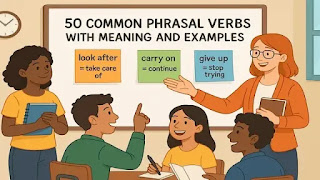What are the 50 Phrasal Verbs with Meaning and Examples?


Mastering English grammar is essential for effective communication, whether you're writing or speaking. Grammar rules provide structure and clarity, ensuring that your message is clear and accurate. If you're wondering what are the 12 basic rules of grammar with examples, here they are, explained to help you understand and apply them in your daily use of the English language.
The subject and verb during a sentence should match in range, which means singular subjects want singular verbs, and plural subjects want plural verbs.
Examples:
Tip: Collective nouns like team or group typically take a singular verb in the English language.
Example: The team is active onerous.
Examples:
Tip: Use "the" once you’re talking regarding one thing specific, and "a/an" once you’re bearing on one thing additional general.
Tenses tell United States once Associate in Nursing action happened, therefore it is vital to stay them consistent. If you are talking regarding one thing that happened within the past, keep on with the past unless you have got a reason to modify.
Examples:
Tip: Use present for facts or general truths, and past for things that have already happened.
Examples:
Tip: To avoid awkwardness with "his or her," you'll build the topic plural:
Correct: All students should submit their comes.
Examples:
Tip: Take care with irregular adverbs. For instance, use "well" rather than "good" to explain how somebody will do something:
Correct: He plays well.
Examples:
Tip: For compound sentences (sentences with over one idea), use conjunctions like "and" or "but" to hitch them properly:
Correct: She finished her homework, and she or he went to bed.
Examples:
Tip: Avoid comma splices that happen once two freelance clauses are joined with simply a comma. Instead, use a conjunction:
Incorrect: She was late; she uncomprehensible the bus.
Correct: She was late, so she uncomprehensible the bus.
Examples:
Tip: Keep the structure consistent in lists and comparisons to create your writing flow better.
Correct: I'll either study onerous or fail to take a look at it.
Examples:
Tip: Seek out words like "not," "no," "never," and "nothing" to make certain you are not accidentally doubling up.
Examples:
Tip: In queries, the ordination changes to verb-subject-object:
Example: Did you see the movie?
Examples:
Tip: Use coordinating conjunctions (for, and, nor, but, or, yet, so) to hitch freelance clauses.
Examples:
Tip: Keep in mind to capitalise vital titles and official names:
Correct: President John F. Kennedy.
Read Often: Reading literate materials helps you choose up correct synchronic linguistic usage naturally.
Use synchronic linguistics tools: Tools like Grammarly will catch common errors and facilitate improving your writing.
By understanding these twelve basic synchronic linguistic rules, you will communicate additional clearly and effectively in English. Whether or not you are writing or speaking, mistreatment of correct synchronic linguistics helps make sure that your message is known.
[Internal Link: scan additional regarding mastering English grammar]
Comments
Post a Comment
Please Don't Enter Any Spam Link In The Comment Box.